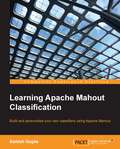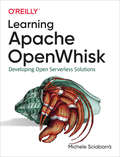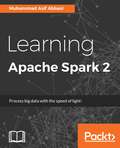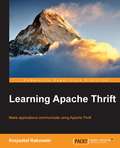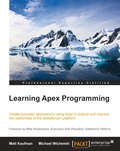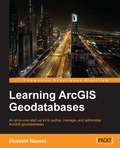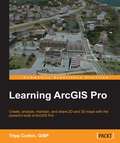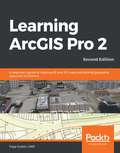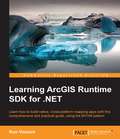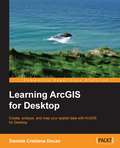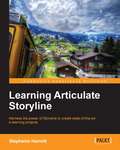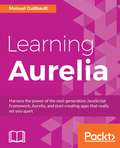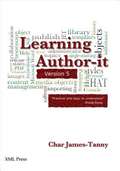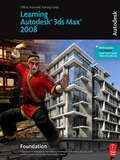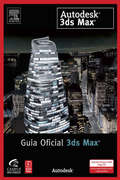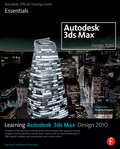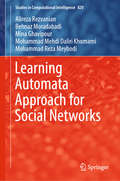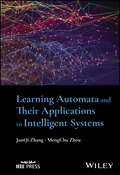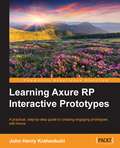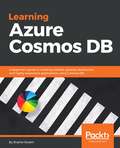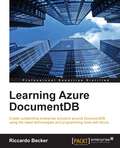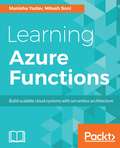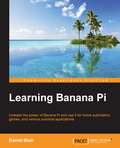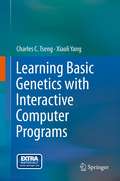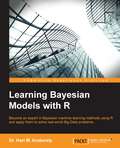- Table View
- List View
Learning Apache Mahout Classification
by Ashish GuptaIf you are a data scientist who has some experience with the Hadoop ecosystem and machine learning methods and want to try out classification on large datasets using Mahout, this book is ideal for you. Knowledge of Java is essential.
Learning Apache OpenWhisk: Developing Open Serverless Solutions
by Michele SciabarràServerless computing greatly simplifies software development. Your team can focus solely on your application while the cloud provider manages the servers you need. This practical guide shows you step-by-step how to build and deploy complex applications in a flexible multicloud, multilanguage environment using Apache OpenWhisk. You’ll learn how this platform enables you to pursue a vendor-independent approach using preconfigured containers, microservices, and Kubernetes as your cloud operating system.Michele Sciabarrà demonstrates how to build a serverless application using classical design patterns and the programming language or languages that best fit your task. You’ll start by building a simple serverless application hands-on before diving into the more complex aspects of the OpenWhisk platform.Examine how OpenWhisk’s serverless architecture works, including the use of packages, actions, sequences, triggers, rules, and feedsLearn how OpenWhisk compares to existing architectures, such as Java Enterprise EditionManipulate OpenWhisk features using the command-line interface or a JavaScript APIDesign applications using common Gang of Four design patternsUse architectural design patterns such as model-view-controller to combine several OpenWhisk actionsLearn how to test and debug your code in a serverless environment
Learning Apache Spark 2
by Muhammad Asif AbbasiLearn about the fastest-growing open source project in the world, and find out how it revolutionizes big data analytics About This Book • Exclusive guide that covers how to get up and running with fast data processing using Apache Spark • Explore and exploit various possibilities with Apache Spark using real-world use cases in this book • Want to perform efficient data processing at real time? This book will be your one-stop solution. Who This Book Is For This guide appeals to big data engineers, analysts, architects, software engineers, even technical managers who need to perform efficient data processing on Hadoop at real time. Basic familiarity with Java or Scala will be helpful. The assumption is that readers will be from a mixed background, but would be typically people with background in engineering/data science with no prior Spark experience and want to understand how Spark can help them on their analytics journey. What You Will Learn • Get an overview of big data analytics and its importance for organizations and data professionals • Delve into Spark to see how it is different from existing processing platforms • Understand the intricacies of various file formats, and how to process them with Apache Spark. • Realize how to deploy Spark with YARN, MESOS or a Stand-alone cluster manager. • Learn the concepts of Spark SQL, SchemaRDD, Caching and working with Hive and Parquet file formats • Understand the architecture of Spark MLLib while discussing some of the off-the-shelf algorithms that come with Spark. • Introduce yourself to the deployment and usage of SparkR. • Walk through the importance of Graph computation and the graph processing systems available in the market • Check the real world example of Spark by building a recommendation engine with Spark using ALS. • Use a Telco data set, to predict customer churn using Random Forests. In Detail Spark juggernaut keeps on rolling and getting more and more momentum each day. Spark provides key capabilities in the form of Spark SQL, Spark Streaming, Spark ML and Graph X all accessible via Java, Scala, Python and R. Deploying the key capabilities is crucial whether it is on a Standalone framework or as a part of existing Hadoop installation and configuring with Yarn and Mesos. The next part of the journey after installation is using key components, APIs, Clustering, machine learning APIs, data pipelines, parallel programming. It is important to understand why each framework component is key, how widely it is being used, its stability and pertinent use cases. Once we understand the individual components, we will take a couple of real life advanced analytics examples such as 'Building a Recommendation system', 'Predicting customer churn' and so on. The objective of these real life examples is to give the reader confidence of using Spark for real-world problems. Style and approach With the help of practical examples and real-world use cases, this guide will take you from scratch to building efficient data applications using Apache Spark. You will learn all about this excellent data processing engine in a step-by-step manner, taking one aspect of it at a time. This highly practical guide will include how to work with data pipelines, dataframes, clustering, SparkSQL, parallel programming, and such insightful topics with the help of real-world use cases.
Learning Apache Thrift
by Krzysztof RakowskiMake applications cross-communicate using Apache Thrift! About This Book * Leverage Apache Thrift to enable applications written in different programming languages (Java, C++, Python, PHP, Ruby, and so on) to cross-communicate. * Learn to make your services ready for real-world applications by using stepwise examples and modifying code from Industry giants. * Be a crackerjack at solving Apache Thrift-related issues. Who This Book Is For If you have some experience of developing applications in one or more languages supported by Apache Thrift (C++, Java, PHP, Python, Ruby, and others) and want to broaden your knowledge and skills in building cross-platform, scalable applications, then this book is for you. What You Will Learn * Understand the need for cross-language services and the basics of Apache Thrift. * Learn how Apache Thrift works and what problems it solves. * Determine when to use Apache Thrift instead of other methods (REST API), and when not to use it. * Create and run an example application using Apache Thrift. * Use Apache Thrift in your applications written in different languages supported by Apache Thrift (PHP, Python, Ruby, Java, and C++). * Handle exceptions and deal with errors. * Modify code in different languages. * Use Apache Thrift in the production environments of big applications. In Detail With modern software systems being increasingly complex, providing a scalable communication architecture for applications in different languages is tedious. The Apache Thrift framework is the solution to this problem! It helps build efficient and easy-to-maintain services and offers a plethora of options matching your application type by supporting several popular programming languages, including C++, Java, Python, PHP, Ruby, Erlang, Perl, Haskell, C#, Cocoa, JavaScript, Node.js, Smalltalk, OCaml, and Delphi. This book will help you set aside the basics of service-oriented systems through your first Apache Thrift-powered app. Then, progressing to more complex examples, it will provide you with tips for running large-scale applications in production environments. You will learn how to assess when Apache Thrift is the best tool to be used. To start with, you will run a simple example application, learning the framework's structure along the way; you will quickly advance to more complex systems that will help you solve various real-life problems. Moreover, you will be able to add a communication layer to every application written in one of the popular programming languages, with support for various data types and error handling. Further, you will learn how pre-eminent companies use Apache Thrift in their popular applications. This book is a great starting point if you want to use one of the best tools available to develop cross-language applications in service-oriented architectures. Style and approach A stepwise guide to learning Apache Thrift, with ready-to-run examples explained comprehensively. Advanced topics supply the inspiration for further work.
Learning Apex Programming
by Matt Kaufman Michael WicherskiIf you are a developer who has some object-oriented programming experience, Learning Apex Programming is the perfect book for you. This book is most appropriate for developers who wish to gain an understanding of the Force.com platform and how to use Apex to create business applications.
Learning ArcGIS Geodatabases
by Hussein NasserThis is a solution-based book, showcasing the real power of ArcGIS Geodatabase by following a real-world, example-based approach. This book is aimed at geospatial developers who want to work with ArcGIS geodatabases as well as manage them. Having knowledge of building a geodatabase from scratch isn't a must; Learning ArcGIS Geodatabases is ideal for those who want to use ArcGIS geodatabase for the first time, or for those who want to migrate from their existing legacy database to a geodatabase.
Learning ArcGIS Pro
by Gisp Tripp CorbinCreate, analyze, maintain, and share 2D and 3D maps with the powerful tools of ArcGIS Pro About This Book * Visualize GIS data in 2D and 3D maps * Create GIS projects for quick and easy access to data, maps, and analysis tools * A practical guide that helps to import maps, globes, and scenes from ArcMap, ArcScene, or ArcGlobe Who This Book Is For This book is for anyone wishing to learn how ArcGIS Pro can be used to create maps and perform geospatial analysis. It will be especially helpful for those that have used ArcMap and ArcCatalog in the past and are looking to migrate to Esri's newest desktop GIS solution. Though previous GIS experience is not required, you must have a solid foundation using Microsoft Windows. It is also helpful if you understand how to manage folders and files within the Microsoft Windows environment. What You Will Learn * Install ArcGIS Pro and assign Licenses to users in your organization * Navigate and use the ArcGIS Pro ribbon interface to create maps and perform analysis * Create and manage ArcGIS Pro GIS Projects * Create 2D and 3D maps to visualize and analyze data * Author map layouts using cartographic tools and best practices to show off the results of your analysis and maps * Import existing map documents, scenes, and globes into your new ArcGIS Pro projects quickly * Create standardized workflows using Tasks * Automate analysis and processes using ModelBuilder and Python In Detail ArcGIS Pro is Esri's newest desktop GIS application with powerful tools for visualizing, maintaining, and analyzing data. ArcGIS Pro makes use of the modern ribbon interface and 64-bit processing to increase the speed and efficiency of using GIS. It allows users to create amazing maps in both 2D and 3D quickly and easily. This book will take you from software installation to performing geospatial analysis. It is packed with how-to's for a host of commonly-performed tasks. You will start by learning how to download and install the software including hardware limitations and recommendations. Then you are exposed to the new Ribbon interface and how its smart design can make finding tools easier. After you are exposed to the new interface, you are walked through the steps to create a new GIS Project to provide quick access to project resources. With a project created, you will learn how to construct 2D and 3D maps including how to add layers, adjust symbology, and control labeling. Next you will learn how to access and use analysis tools to help you answer real-world questions. Lastly, you will learn how processes can be automated and standardized in ArcGIS Pro using Tasks, Models, and Python Scripts. This book will provide an invaluable resource for all those seeking to use ArcGIS Pro as their primary GIS application or for those looking to migrate from ArcMap and ArcCatalog. Style and approach This book includes detailed explanations of the GIS functionality and workflows in ArcGIS Pro. These are supported by easy-to-follow exercises that will help you gain an understanding of how to use ArcGIS Pro to perform a range of tasks.
Learning ArcGIS Pro 2: A beginner's guide to creating 2D and 3D maps and editing geospatial data with ArcGIS Pro, 2nd Edition
by Tripp CorbinCreate 2D maps and 3D scenes, analyze GIS data, and share your results with the GIS community using the latest ArcGIS Pro 2 features Key Features Get up to speed with the new ribbon-based user interface, projects, models, and common workflows in ArcGIS Pro 2 Learn how to visualize, maintain, and analyze GIS data Automate analysis and processes with ModelBuilder and Python scripts Book Description Armed with powerful tools to visualize, maintain, and analyze data, ArcGIS Pro 2 is Esri's newest desktop geographic information system (GIS) application that uses the modern ribbon interface and a 64-bit processor to make using GIS faster and more efficient. This second edition of Learning ArcGIS Pro will show you how you can use this powerful desktop GIS application to create maps, perform spatial analysis, and maintain data. The book begins by showing you how to install ArcGIS and listing the software and hardware prerequisites. You'll then understand the concept of named user licensing and learn how to navigate the new ribbon interface to leverage the power of ArcGIS Pro for managing geospatial data. Once you've got to grips with the new interface, you'll build your first GIS project and understand how to use the different project resources available. The book shows you how to create 2D and 3D maps by adding layers and setting and managing the symbology and labeling. You'll also discover how to use the analysis tool to visualize geospatial data. In later chapters, you'll be introduced to Arcade, the new lightweight expression language for ArcGIS, and then advance to creating complex labels using Arcade expressions. Finally, you'll use Python scripts to automate and standardize tasks and models in ArcGIS Pro. By the end of this ArcGIS Pro book, you'll have developed the core skills needed for using ArcGIS Pro 2.x competently. What you will learn Navigate the user interface to create maps, perform analysis, and manage data Display data based on discrete attribute values or range of values Label features on a GIS map based on one or more attributes using Arcade Create map books using the map series functionality Share ArcGIS Pro maps, projects, and data with other GIS community members Explore the most used geoprocessing tools for performing spatial analysis Create Tasks based on common workflows to standardize processes Automate processes using ModelBuilder and Python scripts Who this book is for If you want to learn ArcGIS Pro to create maps and, edit and analyze geospatial data, this ArcGIS book is for you. No knowledge of GIS fundamentals or experience with any GIS tool or ArcGIS software suite is required. Basic Windows skills, such as navigating and file management, are all you need.
Learning ArcGIS Runtime SDK for .NET
by Ron VincentThis book is for .NET developers who want to learn to build native Geographic Information System (GIS) application.
Learning ArcGIS for Desktop
by Daniela Cristiana DocanCreate, analyze, and map your spatial data with ArcGIS for Desktop About This Book * Learn how to use ArcGIS for Desktop to create and manage geographic data, perform vector and raster analysis, design maps, and share your results * Solve real-world problems and share your valuable results using the powerful instruments of ArcGIS for Desktop * Step-by-step tutorials cover the main editing, analyzing, and mapping tools in ArcGIS for Desktop Who This Book Is For This book is ideal for those who want to learn how to use the most important component of Esri's ArcGIS platform, ArcGIS for Desktop. It would be helpful to have a bit of familiarity with the basic concepts of GIS. Even if you have no prior GIS experience, this book will get you up and running quickly. What You Will Learn * Understand the functionality of ArcGIS for Desktop applications * Explore coordinate reference system concepts and work with different map projections * Create, populate, and document a file geodatabase * Manage, create, and edit feature shapes and attributes * Built automate analysis workfl ows with ModelBuilder * Apply basic principles of map design to create good-looking maps * Analyze raster and three-dimensional data with the Spatial Analyst and 3D Analyst extensions In Detail ArcGIS for Desktop is one of the main components of the ESRI ArcGIS platform used to support decision making and solve real-world mapping problems. Learning ArcGIS for Desktop is a tutorial-based guide that provides a practical experience for those who are interested in start working with ArcGIS. The first five chapters cover the basic concepts of working with the File Geodatabase, as well as editing and symbolizing geospatial data. Then, the book focuses on planning and performing spatial analysis on vector and raster data using the geoprocessing and modeling tools. Finally, the basic principles of cartography design will be used to create a quality map that presents the information that resulted from the spatial analysis previously performed. To keep you learning throughout the chapters, all exercises have partial and final results stored in the dataset that accompanies the book. Finally, the book offers more than it promises by using the ArcGIS Online component in the tutorials as source of background data and for results sharing Style and approach This easy-to-follow guide is full of hands-on exercises that use open and free geospatial datasets. The basic features of the ArcGIS for Desktop are explained in a step-by-step style.
Learning Articulate Storyline
by Stephanie HarnettThis book provides one-on-one tutoring to help you quickly get up to speed with the basics while also learning how to best apply Storyline features in the context of the work you do.If you're an e-learning developer, writer, designer, subject matter expert, or all or any one of these, this book is for you. This book is not just for novices, but also for seasoned developers, transitioning from PowerPoint and Articulate Studio '09, and for those who are already working with Storyline.
Learning Aurelia
by Manuel GuilbaultHarness the power of the next-generation JavaScript Framework, Aurelia, and start creating apps that really set you apart About This Book • Develop well-designed, decoupled, and testable single-page applications with Aurelia • Leverage the latest web standards to increase code performance, readability, and cross-compatibility • Understand how Aurelia is organized and use its innovative MVC approach to design professional-quality web apps Who This Book Is For This book is for JavaScript developers who want to build modern web apps with Aurelia. No prior knowledge of Aurelia is needed. What You Will Learn • Build a modern single-page web application • Understand the workflow of an Aurelia application • Design reusable web components, which can be shared and integrated into various frameworks and libraries • Write clean, modular, and testable code that will be easy to maintain and evolve • Use all the latest–and even future–web standards, so the application gathers minimal technical debt In Detail Aurelia is one of the most promising new JavaScript frameworks for mobile, desktop, and web, which makes developing powerful, modern web applications a straightforward task. Its power lies in its simplicity and clear workflow that enables developers to build next-generations apps for the web with ease. From initial structuring to full deployment, this book will serve as a step-by-step guide to develop a modern web application from scratch with the Aurelia framework. In addition to including a comprehensive coverage of various Aurelia framework features, this book will also show you how to utilize these features in the real world to develop a professional single-page web application. You'll see how to make the most out of Aurelia by understanding the Aurelia workflow and then applying it in real-world development tasks. By the end of the book, you will have learned to develop a clean and maintainable application in Aurelia from scratch. Style and approach This book will show you how to leverage the cutting edge features of Aurelia framework to develop modern web apps with a clear workflow. Using the modern architecture and features of Aurelia, this book will demonstrate the development of a web application from scratch.
Learning Author-it
by Char James-TannyLet Author-it guru Char James-Tanny teach you how to get the most from Author-it. Char has taught hundreds in her acclaimed classes, and now she has drawn from her extensive experience to create the definitive resource for learning Author-it. Whether you are new to Author-it or an experienced user, there is something here for you. If you are just starting out with Author-it, Learning Author-it will make the sometimes daunting learning curve for Author-it smoother and easier. You will learn how libraries work, how to wrap your head around Author-it's object-oriented structure, how to work with your content, and how to publish your output. If you are an experienced Author-it user, get a refresher from someone who uses Author-it like a technical writer. Char provides dozens of tips, helpful screenshots, and more than 150 tasks to help increase your efficiency (and lessen any frustration). And you'll find lots of tips and tricks that will improve your productivity.Inside the Book Understanding and setting up your library Understanding the authoring environment Creating content Reusing topic content Viewing, finding, and organizing topics Publishing the output Customizing objects for different outputs Maintaining the library Index
Learning Autodesk 3ds Max 2008 Foundation
by AutodeskLearning Autodesk® 3ds Max® 2008 | Foundation is your shortcut to learning 3ds Max quickly and effectively. You'll get hands-on experience with the key tools and techniques through easy-to-follow, step-by-step project-based lessons, while learning to model, animate, apply materials and render in both the games & design visualization pipelines. By the end of the book you'll have a sense of the entire production process as you work on real-life production examples.Whether you're a game artist or a graphic artist, Autodesk® 3ds Max® 2008 has the tools you need to succeed. Game Artists will gain in-depth knowledge of the world-class Biped character animation toolset, unparalleled polygon modeling and texturing workflow.Design Visualization Specialists such as architects, designers, and graphic artists, will gain the power to visually inform the design process through conceptual exploration, design validation and visual communication.Bonus features included on DVD:. Link to a 30-day trial of Autodesk® 3ds Max® software. Bonus short films and new software feature demos. Autodesk 3ds Max hotkeys reference guide. Free models from Turbo Squid worth $160. Autodesk® 3ds Max® 2008
Learning Autodesk 3ds Max 2010 Foundation for Games
by Autodesk3ds Max XXXX: presently under NDA. Learning 3ds Max XXXX Foundation is the key to unlocking the power of Autodesk 3ds Max, directly from the creators of one of the world's most powerful 3D animation and effects software products. Get hands on experience with the innovative tools and powerful techniques available in the new version of 3ds Max, through all new project-based lessons. Projects will include valuable game assets and examples. Topics will include modeling, animation, materials & mapping, rendering. Autodesk will be contributing assets (models and images) from high-profile studios. The DVD will include: 30-day trial of Max XXXX, bonus short films, demos, hotkey reference, free models from turbosquid.
Learning Autodesk 3ds Max Design 2010 Essentials: The Official Autodesk 3ds Max Reference
by AutodeskLearning Autodesk 3ds Max XXXX Essentials is a superb end-to-end reference that provides users with complete info on all of the features and options available in the latest version of 3ds Max, so that users can learn how to use 3ds Max confidently in a production environment. Each chapter offers a series of lessons - which introduce the functional areas of Max and go over all associated features (with examples), and then a lab (which demonstrates a practical application of the lesson). Together, all of the lessons deliver and sound and complete approach to revealing the functions, features, and principles of 3ds Max XXXX. New Bonus section on MaxScript covering techniques for automating repetitive tasks and customizing 3ds Max to make you more productive.The DVD includes: Project Scene & support files, Free models & texture maps from Turbo Squid, NEW!! HIGH VALUE: Autodesk product Sketchbook Pro (for character development) valued at $199.99 US.
Learning Automata Approach for Social Networks (Studies in Computational Intelligence #820)
by Alireza Rezvanian Mohammad Reza Meybodi Behnaz Moradabadi Mina Ghavipour Mohammad Mehdi Daliri KhomamiThis book begins by briefly explaining learning automata (LA) models and a recently developed cellular learning automaton (CLA) named wavefront CLA. Analyzing social networks is increasingly important, so as to identify behavioral patterns in interactions among individuals and in the networks’ evolution, and to develop the algorithms required for meaningful analysis. As an emerging artificial intelligence research area, learning automata (LA) has already had a significant impact in many areas of social networks. Here, the research areas related to learning and social networks are addressed from bibliometric and network analysis perspectives. In turn, the second part of the book highlights a range of LA-based applications addressing social network problems, from network sampling, community detection, link prediction, and trust management, to recommender systems and finally influence maximization. Given its scope, the book offers a valuable guide for all researchers whose work involves reinforcement learning, social networks and/or artificial intelligence.
Learning Automata and Their Applications to Intelligent Systems
by MengChu Zhou JunQi ZhangComprehensive guide on learning automata, introducing two variants to accelerate convergence and computational update speed Learning Automata and Their Applications to Intelligent Systems provides a comprehensive guide on learning automata from the perspective of principles, algorithms, improvement directions, and applications. The text introduces two variants to accelerate the convergence speed and computational update speed, respectively; these two examples demonstrate how to design new learning automata for a specific field from the aspect of algorithm design to give full play to the advantage of learning automata. As noisy optimization problems exist widely in various intelligent systems, this book elaborates on how to employ learning automata to solve noisy optimization problems from the perspective of algorithm design and application. The existing and most representative applications of learning automata include classification, clustering, game, knapsack, network, optimization, ranking, and scheduling. They are well-discussed. Future research directions to promote an intelligent system are suggested. Written by two highly qualified academics with significant experience in the field, Learning Automata and Their Applications to Intelligent Systems covers such topics as: Mathematical analysis of the behavior of learning automata, along with suitable learning algorithms Two application-oriented learning automata: one to discover and track spatiotemporal event patterns, and the other to solve stochastic searching on a line Demonstrations of two pioneering variants of Optimal Computing Budge Allocation (OCBA) methods and how to combine learning automata with ordinal optimization How to achieve significantly faster convergence and higher accuracy than classical pursuit schemes via lower computational complexity of updating the state probabilityA timely text in a rapidly developing field, Learning Automata and Their Applications to Intelligent Systems is an essential resource for researchers in machine learning, engineering, operation, and management. The book is also highly suitable for graduate level courses on machine learning, soft computing, reinforcement learning and stochastic optimization.
Learning Axure RP Interactive Prototypes
by John Henry KrahenbuhlIf you are a user experience professional, designer, information architect, or business analyst who wants to gain interactive prototyping skills with Axure, then this book is ideal for you. Some familiarity with Axure is preferred but not essential.
Learning Azure Cosmos DB: A beginner's guide to creating scalable, globally distributed, and highly responsive applications using Cosmos DB
by Shahid ShaikhGain an in-depth understanding of Azure Cosmos DB — a multi-model database from Microsoft Key FeaturesDevelop your skills to build and scale applications using the power of Azure CosmosDB.Learn how to store and access data with a variety of APIs including MongoDB, Gremlin, SQL, Azure Tables and much more.Fast paced guide to have a better understanding of the features with the practical approach mentioned.Book DescriptionMicrosoft has introduced a new globally distributed database, called Azure Cosmos DB. It is a superset of Microsoft's existing NoSQL Document DB service. Azure Cosmos DB enables you to scale throughput and storage elastically and independently across any number of Azure's geographic regions.This book is a must-have for anyone who wants to get introduced to the world of Cosmos DB. This book will focus on building globally-distributed applications without the hassle of complex, multiple datacenter configurations. This book will shed light on how Cosmos DB offers multimodal NoSQL database capabilities in the cloud at a scale that is one product with different database engines, such as key-value, document, graph, and wide column store. We will cover detailed practical examples on how to create a CRUD application using Cosmos DB with a frontend framework of your choice. This book will empower developers to choose their favorite database engines to perform integration, along with other systems that utilize the most popular languages, such as Node.js. This book will take you through the tips and trick, of Cosmos DB deployment, management, and the security offered by Azure Cosmos DB in order to detect, prevent, and respond to database breaches.By the end of this book, you will not only be aware of the best capabilities of relational and non-relational databases, but you will also be able to build scalable, globally distributed,and highly responsive applications.What you will learnBuild highly responsive and mission-critical applicationsUnderstand how distributed databases are important for global scale and low latencyUnderstand how to write globally distributed applications the right wayImplement comprehensive SLAs for throughput, latency, consistency,and availabilityImplement multiple data models and popular APIs for accessing and querying dataImplement best practices covering data security in order to detect, prevent andrespond to database breachesWho this book is forThis book is intended to anyone who wants to get well versed with Microsoft's new NoSQL database called Azure Cosmos DB. Get the database into work with the practical examples mentioned.
Learning Azure DocumentDB
by Riccardo BeckerCreate outstanding enterprise solutions around DocumentDB using the latest technologies and programming tools with Azure About This Book * Get to know the concepts of DocumentDB and learn to work your way around it * Manipulate and query your documents using different modern technologies to access DocumentDB * Build a real-life scenario using Microsoft Visual Studio and C# with this handy and practical guide Who This Book Is For This book is for novice developers and database architects who need a thorough knowledge of the features of DocumentDB and developing applications with it. Basic knowledge of SQL would be helpful. What You Will Learn * Create, manage, and configure your DocumentDB environment * Execute SQL queries from simple to complex and nested ones against your database * Get to know about advanced DocumentDB techniques such as scopes, portioning, indexing, triggers, UDF's, and security * Fine-tune your DocumentDB database to optimize performance and costs * Interact with DocumentDB from different technologies and platforms * Build a real-life scenario using C# and put DocumentDB at the heart of Azure solutions * Understand how to migrate from your current datastore to DocumentDB In Detail Learning DocumentDB adopts a practical, step-by-step approach to help you learn the basics of DocumentDB and use your new-found abilities in real-life scenarios and enterprise solutions. We start with the absolute basics, such as setting up a DocumentDB environment, and guide you through managing your databases, and executing simple and complex queries. Next, we explain how to work with DocumentDB using the open REST protocol, and demonstrate how JavaScript works with DocumentDB. We'll also show you how to authenticate and execute queries. Moving on, you'll find out how to use DocumentDB from within Node.js to kick-start your Node.js projects. Next, you'll discover how to increase the performance of your DocumentDB database and fine-tune it. Finally, you'll get to grips with using DocumentDB in conjunction with other services offered from the Microsoft Azure platform. Style and approach This book can be used as a tutorial where you learn step by step, but also as a knowledge base to quickly look up recipes you can instantly utilize. Starting with the basics and moving on to advanced topics, every concept is explained in theory and demonstrated through easy-to-understand examples.
Learning Azure Functions
by Mitesh Soni Manisha YadavThis book will start with the basics of Azure Functions. You will learn the steps to set up the environment and the tools that we will be using in the further chapters. Once you have a better understanding of this, we will be creating our first hello world function app. Later you will be introduced to triggers, how they are used to activate a function, and how binding can be used to output results of a function.You will also explore the steps to create an assembly with complex functionality that can be used by functions. Next, this book will teach you to scale your functions and use them to process data, integrate systems, and build simple APIs and microservices. Finally, this book will cover some diagnostic techniques with Azure App services and best practices of working with Azure Functions. By the end of this book, you will be well-versed with the techniques of scaling your Azure functions and making the most of serverless architecture.
Learning Banana Pi
by Daniel BlairThis book is for anyone who wants to explore Banana Pi and get started building projects on their own using it. No prior experience of working with single board computers is required.
Learning Basic Genetics with Interactive Computer Programs
by Charles C. Tseng Xiaoli YangTraditionally, genetics laboratory exercises at the university level focus on mono- and dihybrid crosses and phenotypic analysis--exercises under traditional time, materials, and process constraints. Lately, molecular techniques such as gene cloning, polymerase chain reactions (PCR), and bioinformatics are being included in many teaching laboratories--where affordable. Human chromosome analysis, when present at all, has often been restricted to simple identification of chromosomes by number, through the usual "cut-and-paste" method. Although several online karyotyping (chromosome identification) programs have become available, they are not meaningful for studying the dynamics of the chromosome system, nor do they help students understand genetics as a discipline. The software that accompanies this book has been shown to be an ideal tool for learning about genetics, which requires a combination of understanding, conceptualization, and practical experience.
Learning Bayesian Models with R
by Dr Hari M. KoduvelyThis book is for statisticians, analysts, and data scientists who want to build a Bayes-based system with R and implement it in their day-to-day models and projects. It is mainly intended for Data Scientists and Software Engineers who are involved in the development of Advanced Analytics applications. To understand this book, it would be useful if you have basic knowledge of probability theory and analytics and some familiarity with the programming language R.
